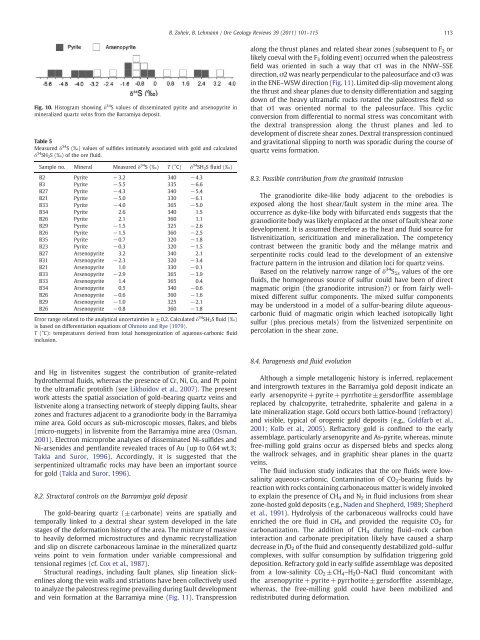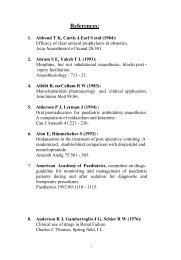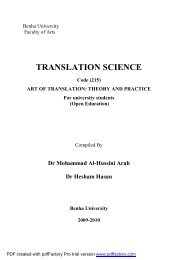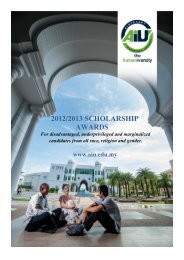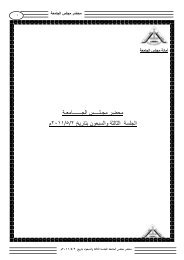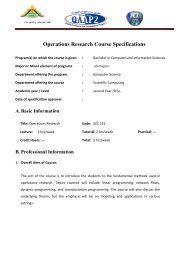Basem Ahmed Zoheir_Barramiya, OGR_2011.pdf
Basem Ahmed Zoheir_Barramiya, OGR_2011.pdf
Basem Ahmed Zoheir_Barramiya, OGR_2011.pdf
You also want an ePaper? Increase the reach of your titles
YUMPU automatically turns print PDFs into web optimized ePapers that Google loves.
Fig. 10. Histogram showing δ 34 S values of disseminated pyrite and arsenopyrite in<br />
mineralized quartz veins from the <strong>Barramiya</strong> deposit.<br />
Table 5<br />
Measured δ 34 S(‰) values of sulfides intimately associated with gold and calculated<br />
δ 34 SH 2S(‰) of the ore fluid.<br />
Sample no. Mineral Measured δ 34 S(‰) T (°C) δ 34 SH2S fluid (‰)<br />
B2 Pyrite −3.2 340 −4.3<br />
B3 Pyrite −5.5 335 −6.6<br />
B27 Pyrite −4.3 340 −5.4<br />
B21 Pyrite −5.0 330 −6.1<br />
B33 Pyrite −4.0 365 −5.0<br />
B34 Pyrite 2.6 340 1.5<br />
B26 Pyrite 2.1 360 1.1<br />
B29 Pyrite −1.5 325 −2.6<br />
B26 Pyrite −1.5 360 −2.5<br />
B35 Pyrite −0.7 320 −1.8<br />
B23 Pyrite −0.3 320 −1.5<br />
B27 Arsenopyrite 3.2 340 2.1<br />
B31 Arsenopyrite −2.3 320 −3.4<br />
B21 Arsenopyrite 1.0 330 −0.1<br />
B33 Arsenopyrite −2.9 365 −3.9<br />
B33 Arsenopyrite 1.4 365 0.4<br />
B34 Arsenopyrite 0.5 340 −0.6<br />
B26 Arsenopyrite −0.6 360 −1.6<br />
B29 Arsenopyrite −1.0 325 −2.1<br />
B26 Arsenopyrite −0.8 360 −1.8<br />
Error range related to the analytical uncertainties is ±0.2. Calculated δ 34 SH2S fluid (‰)<br />
is based on differentiation equations of Ohmoto and Rye (1979).<br />
T (°C): temperatures derived from total homogenization of aqueous-carbonic fluid<br />
inclusion.<br />
and Hg in listvenites suggest the contribution of granite-related<br />
hydrothermal fluids, whereas the presence of Cr, Ni, Co, and Pt point<br />
to the ultramafic protolith (see Likhoidov et al., 2007). The present<br />
work attests the spatial association of gold-bearing quartz veins and<br />
listvenite along a transecting network of steeply dipping faults, shear<br />
zones and fractures adjacent to a granodiorite body in the <strong>Barramiya</strong><br />
mine area. Gold occurs as sub-microscopic mosses, flakes, and blebs<br />
(micro-nuggets) in listvenite from the <strong>Barramiya</strong> mine area (Osman,<br />
2001). Electron microprobe analyses of disseminated Ni-sulfides and<br />
Ni-arsenides and pentlandite revealed traces of Au (up to 0.64 wt.%;<br />
Takla and Suror, 1996). Accordingly, it is suggested that the<br />
serpentinized ultramafic rocks may have been an important source<br />
for gold (Takla and Suror, 1996).<br />
8.2. Structural controls on the <strong>Barramiya</strong> gold deposit<br />
The gold-bearing quartz (±carbonate) veins are spatially and<br />
temporally linked to a dextral shear system developed in the late<br />
stages of the deformation history of the area. The mixture of massive<br />
to heavily deformed microstructures and dynamic recrystallization<br />
and slip on discrete carbonaceous laminae in the mineralized quartz<br />
veins point to vein formation under variable compressional and<br />
tensional regimes (cf. Cox et al., 1987).<br />
Structural readings, including fault planes, slip lineation slickenlines<br />
along the vein walls and striations have been collectively used<br />
to analyze the paleostress regime prevailing during fault development<br />
and vein formation at the <strong>Barramiya</strong> mine (Fig. 11). Transpression<br />
B. <strong>Zoheir</strong>, B. Lehmann / Ore Geology Reviews 39 (2011) 101–115<br />
along the thrust planes and related shear zones (subsequent to F2 or<br />
likely coeval with the F 3 folding event) occurred when the paleostress<br />
field was oriented in such a way that σ1 was in the NNW–SSE<br />
direction, σ2 was nearly perpendicular to the paleosurface and σ3was<br />
in the ENE–WSW direction (Fig. 11). Limited dip-slip movement along<br />
the thrust and shear planes due to density differentiation and sagging<br />
down of the heavy ultramafic rocks rotated the paleostress field so<br />
that σ1 was oriented normal to the paleosurface. This cyclic<br />
conversion from differential to normal stress was concomitant with<br />
the dextral transpression along the thrust planes and led to<br />
development of discrete shear zones. Dextral transpression continued<br />
and gravitational slipping to north was sporadic during the course of<br />
quartz veins formation.<br />
8.3. Possible contribution from the granitoid intrusion<br />
The granodiorite dike-like body adjacent to the orebodies is<br />
exposed along the host shear/fault system in the mine area. The<br />
occurrence as dyke-like body with bifurcated ends suggests that the<br />
granodiorite body was likely emplaced at the onset of fault/shear zone<br />
development. It is assumed therefore as the heat and fluid source for<br />
listvenitization, sericitization and mineralization. The competency<br />
contrast between the granitic body and the mélange matrix and<br />
serpentinite rocks could lead to the development of an extensive<br />
fracture pattern in the intrusion and dilation loci for quartz veins.<br />
Based on the relatively narrow range of δ 34 S Σs values of the ore<br />
fluids, the homogeneous source of sulfur could have been of direct<br />
magmatic origin (the granodiorite intrusion?) or from fairly wellmixed<br />
different sulfur components. The mixed sulfur components<br />
may be understood in a model of a sulfur-bearing dilute aqueouscarbonic<br />
fluid of magmatic origin which leached isotopically light<br />
sulfur (plus precious metals) from the listvenized serpentinite on<br />
percolation in the shear zone.<br />
8.4. Paragenesis and fluid evolution<br />
Although a simple metallogenic history is inferred, replacement<br />
and intergrowth textures in the <strong>Barramiya</strong> gold deposit indicate an<br />
early arsenopyrite+pyrite+pyrrhotite±gersdorffite assemblage<br />
replaced by chalcopyrite, tetrahedrite, sphalerite and galena in a<br />
late mineralization stage. Gold occurs both lattice-bound (refractory)<br />
and visible, typical of orogenic gold deposits (e.g., Goldfarb et al.,<br />
2001; Kolb et al., 2005). Refractory gold is confined to the early<br />
assemblage, particularly arsenopyrite and As-pyrite, whereas, minute<br />
free-milling gold grains occur as dispersed blebs and specks along<br />
the wallrock selvages, and in graphitic shear planes in the quartz<br />
veins.<br />
The fluid inclusion study indicates that the ore fluids were lowsalinity<br />
aqueous-carbonic. Contamination of CO2-bearing fluids by<br />
reaction with rocks containing carbonaceous matter is widely invoked<br />
to explain the presence of CH4 and N2 in fluid inclusions from shear<br />
zone-hosted gold deposits (e.g., Naden and Shepherd, 1989; Shepherd<br />
et al., 1991). Hydrolysis of the carbonaceous wallrocks could have<br />
enriched the ore fluid in CH 4 and provided the requisite CO 2 for<br />
carbonatization. The addition of CH4 during fluid–rock carbon<br />
interaction and carbonate precipitation likely have caused a sharp<br />
decrease in fO2 of the fluid and consequently destabilized gold–sulfur<br />
complexes, with sulfur consumption by sulfidation triggering gold<br />
deposition. Refractory gold in early sulfide assemblage was deposited<br />
from a low-salinity CO 2±CH 4–H 2O–NaCl fluid concomitant with<br />
the arsenopyrite+pyrite+pyrrhotite ±gersdorffite assemblage,<br />
whereas, the free-milling gold could have been mobilized and<br />
redistributed during deformation.<br />
113


